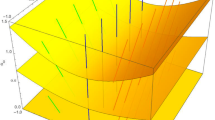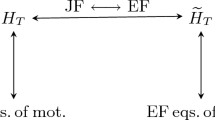Abstract
The causal characters (spacelike, lightlike, timelike) of the coordinate lines, coordinate surfaces and coordinate hypersurfaces of a coordinate system in Relativity define what is called its causal class. It is known that, in any relativistic space-time, there exist one hundred and ninety nine such causal classes. But in Newtonian physics (where only spacelike and timelike characters exist) the corresponding causal classes have not been discussed until recently. Here it is shown that, in sharp contrast with the relativistic case, in Newtonian space-time the different causal classes of coordinate systems are drastically reduced to four. These causal classes admit simple geometric descriptions and physical interpretations. For example, it is shown that one can generate coordinate systems of the four causal classes by means of the sole linear synchronization group, i.e. by coordinate transformations that only change the origin of time linearly. The relativistic analogs of these examples are also considered.
Similar content being viewed by others
References
Coll, B., Morales, J.A.: 199 Causal classes of space-time frames. Int. J. Theor. Phys. 31, 1045–1062 (1992)
Coll, B., Martín, J.J. (eds.): In: Proc. Int. School on Relativistic Coordinates, Reference and Positioning Systems, Salamanca, 2005. Universidad de Salamanca (in press)
Coll, B.: Elements for a theory of relativistic coordinate systems. Formal and physical aspects. In: Pascual-Sánchez, J.F., Floría, L., San Miguel, A., Vicente, F. (eds.) Proceedings of the XXIII Spanish Relativity Meeting ERE-2000 on Reference Frames and Gravitomagnetism, pp. 53–65. World Scientific, Singapore (2001). http//coll.cc
Bahder, T.B.: Navigation in curved space-time. Am. J. Phys. 69, 315–321 (2001)
Rovelli, C.: GPS observables in general relativity. Phys. Rev. D 65, 044017 (2002)
Blagojević, M., Garecki, J., Hehl, F.W., Obukhov, Y.N.: Real null coframes in general relativity and GPS type coordinates. Phys. Rev. D 65, 044018 (2002)
Lachièze-Rey, M.: The covariance of GPS coordinates and frames. Class. Quantum Gravity 23, 3531–3544 (2006)
Coll, B., Ferrando, J.J., Morales, J.A.: Two-dimensional approach to relativistic positioning systems. Phys. Rev. D 73, 084017 (2006)
Coll, B., Ferrando, J.J., Morales, J.A.: Positioning with stationary emitters in a two-dimensional space-time. Phys. Rev. D 74, 104003 (2006)
Coll, B., Pozo, J.M.: Relativistic positioning systems: the emission coordinates. Class. Quantum. Gravity 23, 7395–7416 (2006)
Bini, D., Geralico, A., Ruggiero, M.L., Tartaglia, A.: Emission vs Fermi coordinates: applications to relativistic positioning systems. Class. Quantum. Gravity 25, 205011 (2008)
Coll, B., Ferrando, J.J., Morales, J.A.: Emission coordinates in Minkowski space-time. In: Kunze, K.E., Mars, M., Vázquez-Mozo, M.A. (eds.) Physics and Mathematics of Gravitation, Proceedings of the XXXIth Spanish Relativity Meeting ERE-2008. AIP Conference Proceedings, vol. 1122, pp. 225–228. AIP, New York (2009)
Coll, B.: Temps uniforme et indice d’un fluid en relativité. Manuscript (1972). http://coll.cc
Cartan, E.: Sur les variétés à connexion affine et la théorie de la relativité generalisée. Ann. Sci. École Norm. Sup. 41, 1–25 (1924)
Trautman, A.: Sur la théorie newtonienne de la gravitation. C.R. Acad. Sci. Paris 257, 617–720 (1963). For completeness, see Trautman, A.: Comparison of Newtonian and relativistic theories of space-time. In: B. Hoffmann (ed.) Perspectives in Geometry and Relativity. Essays in Honor of Vlácav Hlavaty, pp. 413–424. Bloomington, Indiana Univ. Press, 1966
Rüede, C., Strautmann, N.: On Newton-Cartan Cosmology. Helv. Phys. Acta 70, 318–335 (1997). See also arXiv:gr-qc/9604054
Coll, B., Ferrando, J.J., Morales, J.A.: Newtonian and Lorentzian emission coordinates. Phys. Rev. D 80, 064038 (2009)
Author information
Authors and Affiliations
Corresponding author
Rights and permissions
About this article
Cite this article
Coll, B., Ferrando, J.J. & Morales-Lladosa, J.A. Four Causal Classes of Newtonian Frames. Found Phys 39, 1280 (2009). https://doi.org/10.1007/s10701-009-9353-2
Received:
Accepted:
Published:
DOI: https://doi.org/10.1007/s10701-009-9353-2




